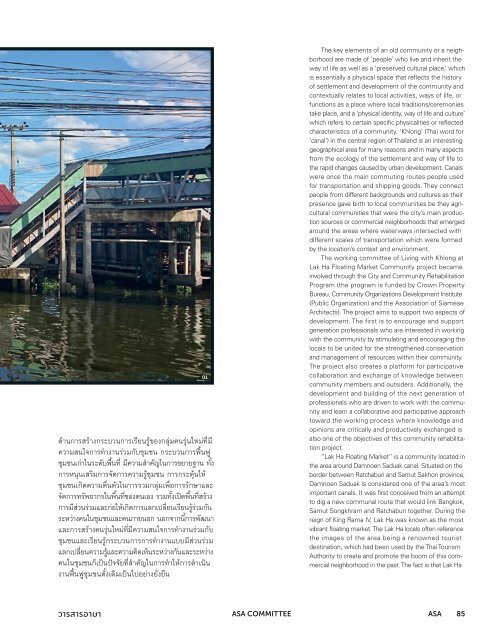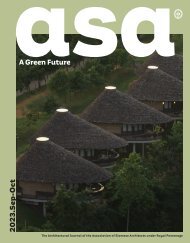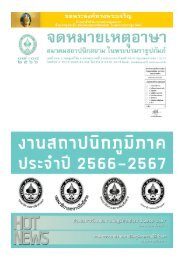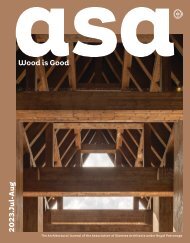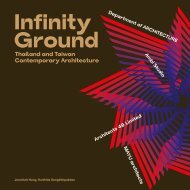ASA JOURNAL 06/59
You also want an ePaper? Increase the reach of your titles
YUMPU automatically turns print PDFs into web optimized ePapers that Google loves.
ด้านการสร้างกระบวนการเรียนรู้ของกลุ่มคนรุ่นใหม่ที่มี<br />
ความสนใจการทางานร่วมกับชุมชน กระบวนการฟื้นฟู<br />
ชุมชนเก่าในระดับพื้นที่ มีความสาคัญในการขยายฐาน ทั้ง<br />
การหนุนเสริมการจัดการความรู้ชุมชน การกระตุ้นให้<br />
ชุมชนเกิดความตื่นตัวในการรวมกลุ่มเพื่อการรักษาและ<br />
จัดการทรัพยากรในพื้นที่ของตนเอง รวมทั้งเปิดพื้นที่สร้าง<br />
การมีส่วนร่วมและก่อให้เกิดการแลกเปลี่ยนเรียนรู้ร่วมกัน<br />
ระหว่างคนในชุมชนและคนภายนอก นอกจากนี้การพัฒนา<br />
และการสร้างคนรุ่นใหม่ที่มีความสนใจการทางานร่วมกับ<br />
ชุมชนและเรียนรู้กระบวนการการทางานแบบมีส่วนร่วม<br />
แลกเปลี่ยนความรู้และความคิดเห็นระหว่างกันและระหว่าง<br />
คนในชุมชนก็เป็นปัจจัยที่สาคัญในการทาให้การดาเนิน<br />
งานฟื้นฟูชุมชนดั้งเดิมเป็นไปอย่างยั่งยืน<br />
01<br />
The key elements of an old community or a neighborhood<br />
are made of ‘people’ who live and inherit the<br />
way of life as well as a ‘preserved cultural place,’ which<br />
is essentially a physical space that reflects the history<br />
of settlement and development of the community and<br />
contextually relates to local activities, ways of life, or<br />
functions as a place where local traditions/ceremonies<br />
take place, and a ‘physical identity, way of life and culture’<br />
which refers to certain specific physicalities or reflected<br />
characteristics of a community. ‘Khlong’ (Thai word for<br />
‘canal’) in the central region of Thailand is an interesting<br />
geographical area for many reasons and in many aspects<br />
from the ecology of the settlement and way of life to<br />
the rapid changes caused by urban development. Canals<br />
were once the main commuting routes people used<br />
for transportation and shipping goods. They connect<br />
people from different backgrounds and cultures as their<br />
presence gave birth to local communities be they agricultural<br />
communities that were the city’s main production<br />
sources or commercial neighborhoods that emerged<br />
around the areas where waterways intersected with<br />
different scales of transportation which were formed<br />
by the location’s context and environment.<br />
The working committee of Living with Khlong at<br />
Lak Ha Floating Market Community project became<br />
involved through the City and Community Rehabilitation<br />
Program (the program is funded by Crown Property<br />
Bureau, Community Organizations Development Institute<br />
(Public Organization) and the Association of Siamese<br />
Architects). The project aims to support two aspects of<br />
development. The first is to encourage and support<br />
generation professionals who are interested in working<br />
with the community by stimulating and encouraging the<br />
locals to be united for the strengthened conservation<br />
and management of resources within their community.<br />
The project also creates a platform for participative<br />
collaboration and exchange of knowledge between<br />
community members and outsiders. Additionally, the<br />
development and building of the next generation of<br />
professionals who are driven to work with the community<br />
and learn a collaborative and participative approach<br />
toward the working process where knowledge and<br />
opinions are critically and productively exchanged is<br />
also one of the objectives of this community rehabilitation<br />
project.<br />
“Lak Ha Floating Market“ is a community located in<br />
the area around Damnoen Saduak canal. Situated on the<br />
border between Ratchaburi and Samut Sakhon province,<br />
Damnoen Saduak is considered one of the area’s most<br />
important canals. It was first conceived from an attempt<br />
to dig a new communal route that would link Bangkok,<br />
Samut Songkhram and Ratchaburi together. During the<br />
reign of King Rama IV, Lak Ha was known as the most<br />
vibrant floating market. The Lak Ha locals often reference<br />
the images of the area being a renowned tourist<br />
destination, which had been used by the Thai Tourism<br />
Authority to create and promote the boom of this commercial<br />
neighborhood in the past. The fact is that Lak Ha<br />
วารสารอาษา<br />
<strong>ASA</strong> COMMITTEE <strong>ASA</strong> 85


